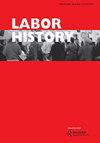补偿法及其对抗性管理:1923-71年印度拉尼甘吉煤田
IF 0.7
4区 管理学
Q1 HISTORY
引用次数: 1
摘要
本文论述了1923年至1971年印度拉尼甘吉煤田补偿法的制定和实施。它展示了1923–24年颁布的《工人赔偿法》是如何在殖民地和后殖民地的印度形成一个主要的社会保险计划的。尽管如此,诉讼性和对抗性的行政成为其决定性特征。在长达半个世纪的运作中,这一特点降低了赔偿法作为补偿悲痛家庭的措施,以及作为对工人安全投资的激励的效用。自20世纪20年代末以来,悲痛欲绝的家庭登记了越来越多的索赔,以获得赔偿金。与此同时,直到20世纪50年代,雇主对工人索赔提出异议的人数也居高不下。管理赔偿金的繁琐执法程序,加上煤矿管理层设计的一系列话语和法律技巧,给工人争取索赔的努力带来了障碍。自20世纪50年代末以来,工人争取补偿福利的努力出现了有利的转变,这得益于对补偿法的简化和精简。然而,工人在赔偿办公室和民事法院所经历的法律程序的复杂性和费用通常增加了他们的痛苦。本文章由计算机程序翻译,如有差异,请以英文原文为准。
The compensation law and its antagonistic administration: The Indian coalfield of Raniganj, 1923-71
ABSTRACT This article elaborates on the stipulation and administration of the compensation law, in the Indian coalfield of Raniganj, between 1923 and 1971. It shows how enacting the Workmen’s Compensation Act of 1923–24 formed a major social insurance scheme in colonial and post-colonial India. Notwithstanding this, the litigious and antagonistic administration became its defining feature. This feature lowered the utility of the compensation law as a restitution measure for grieving families, and as an incentive for investment in workers’ safety, during its half- century-long operation. Grief-stricken families registered an increasing number of claims to avail of compensation benefits from the later 1920s. Concomitantly, the number of employers’ contestation against workers’ claims also remained significantly high till the 1950s. The cumbersome procedure of law enforcement for administering compensation benefits, alongside an array of discursive-cum-legal techniques devised by the colliery management, caused hurdles in the workers’ attempt to secure their claims. The favourable turnaround in workers’ effort to secure compensation benefits from the late 1950s resulted from an enabling simplification and streamlining brought to the compensation law. However, the complication and expenses of the legal procedure that workers endured in the Compensation Office and Civil Courts generally added to their miseries.
求助全文
通过发布文献求助,成功后即可免费获取论文全文。
去求助
来源期刊

Labor History
Multiple-
CiteScore
1.00
自引率
28.60%
发文量
44
期刊介绍:
Labor History is the pre-eminent journal for historical scholarship on labor. It is thoroughly ecumenical in its approach and showcases the work of labor historians, industrial relations scholars, labor economists, political scientists, sociologists, social movement theorists, business scholars and all others who write about labor issues. Labor History is also committed to geographical and chronological breadth. It publishes work on labor in the US and all other areas of the world. It is concerned with questions of labor in every time period, from the eighteenth century to contemporary events. Labor History provides a forum for all labor scholars, thus helping to bind together a large but fragmented area of study. By embracing all disciplines, time frames and locales, Labor History is the flagship journal of the entire field. All research articles published in the journal have undergone rigorous peer review, based on initial editor screening and refereeing by at least two anonymous referees.
 求助内容:
求助内容: 应助结果提醒方式:
应助结果提醒方式:


